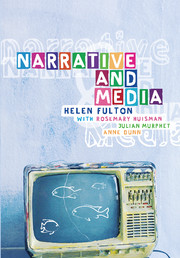Book contents
- Frontmatter
- Contents
- Figures and tables
- Contributors
- Acknowledgements
- 1 Introduction: the power of narrative
- Part 1 The basics of narrative theory
- Part 2 Film as narrative and visual mode
- 4 Stories and plots
- 5 Narrative time
- 6 Narrative voice
- 7 Point of view
- 8 Novel to film
- 9 Film narrative and visual cohesion
- Part 3 Television: narratives and ideology
- Part 4 Radio and print journalism
- Part 5 Popular print culture
- Glossary
- Bibliography
- Index
8 - Novel to film
Published online by Cambridge University Press: 05 June 2012
- Frontmatter
- Contents
- Figures and tables
- Contributors
- Acknowledgements
- 1 Introduction: the power of narrative
- Part 1 The basics of narrative theory
- Part 2 Film as narrative and visual mode
- 4 Stories and plots
- 5 Narrative time
- 6 Narrative voice
- 7 Point of view
- 8 Novel to film
- 9 Film narrative and visual cohesion
- Part 3 Television: narratives and ideology
- Part 4 Radio and print journalism
- Part 5 Popular print culture
- Glossary
- Bibliography
- Index
Summary
The process of reworking a written text, such as a novel, into an image-based text, such as a film, reveals the different narrative conventions of the two media. In this chapter, I am primarily interested in the ways in which the narrative conventions and techniques of film work to create meanings, so that a novel and its film adaptation, although clearly related, tend to have different themes and goals. I will be referring mainly to two films, The English Patient (written and directed by Anthony Minghella, 1996) and The Lord of the Rings: The Fellowship of the Ring (directed by Peter Jackson, screenplay by Frances Walsh, 2001), and the corresponding novels, The English Patient by Michael Ondaatje (1992) and The Lord of the Rings, Part 1: The Fellowship of the Ring by J. R. R. Tolkien (1949).
Issues of adaptation
The novelist John Irving, who wrote the screenplay for the film The Cider House Rules based on his own novel, has said, ‘Even when you don't have to lose much in an adaptation from book to screen, you always lose something. Screenwriters learn to compensate for what they've lost … In an adaptation, you can't be too literally wedded to the novel. You have to take advantage of what a film can do’ (Guardian, 28 January 2005, ‘Friday Review’, p. 11).
- Type
- Chapter
- Information
- Narrative and Media , pp. 96 - 107Publisher: Cambridge University PressPrint publication year: 2005



